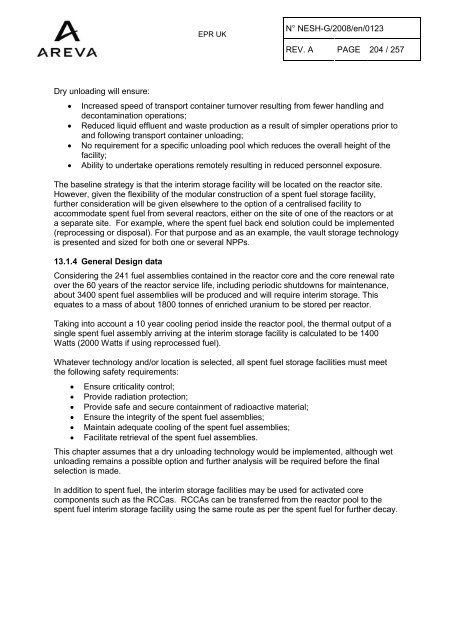Solid Radioactive Waste Strategy Report.pdf - UK EPR
Solid Radioactive Waste Strategy Report.pdf - UK EPR
Solid Radioactive Waste Strategy Report.pdf - UK EPR
Create successful ePaper yourself
Turn your PDF publications into a flip-book with our unique Google optimized e-Paper software.
<strong>EPR</strong> <strong>UK</strong><br />
N° NESH-G/2008/en/0123<br />
REV. A PAGE 204 / 257<br />
Dry unloading will ensure:<br />
· Increased speed of transport container turnover resulting from fewer handling and<br />
decontamination operations;<br />
· Reduced liquid effluent and waste production as a result of simpler operations prior to<br />
and following transport container unloading;<br />
· No requirement for a specific unloading pool which reduces the overall height of the<br />
facility;<br />
· Ability to undertake operations remotely resulting in reduced personnel exposure.<br />
The baseline strategy is that the interim storage facility will be located on the reactor site.<br />
However, given the flexibility of the modular construction of a spent fuel storage facility,<br />
further consideration will be given elsewhere to the option of a centralised facility to<br />
accommodate spent fuel from several reactors, either on the site of one of the reactors or at<br />
a separate site. For example, where the spent fuel back end solution could be implemented<br />
(reprocessing or disposal). For that purpose and as an example, the vault storage technology<br />
is presented and sized for both one or several NPPs.<br />
13.1.4 General Design data<br />
Considering the 241 fuel assemblies contained in the reactor core and the core renewal rate<br />
over the 60 years of the reactor service life, including periodic shutdowns for maintenance,<br />
about 3400 spent fuel assemblies will be produced and will require interim storage. This<br />
equates to a mass of about 1800 tonnes of enriched uranium to be stored per reactor.<br />
Taking into account a 10 year cooling period inside the reactor pool, the thermal output of a<br />
single spent fuel assembly arriving at the interim storage facility is calculated to be 1400<br />
Watts (2000 Watts if using reprocessed fuel).<br />
Whatever technology and/or location is selected, all spent fuel storage facilities must meet<br />
the following safety requirements:<br />
· Ensure criticality control;<br />
· Provide radiation protection;<br />
· Provide safe and secure containment of radioactive material;<br />
· Ensure the integrity of the spent fuel assemblies;<br />
· Maintain adequate cooling of the spent fuel assemblies;<br />
· Facilitate retrieval of the spent fuel assemblies.<br />
This chapter assumes that a dry unloading technology would be implemented, although wet<br />
unloading remains a possible option and further analysis will be required before the final<br />
selection is made.<br />
In addition to spent fuel, the interim storage facilities may be used for activated core<br />
components such as the RCCas. RCCAs can be transferred from the reactor pool to the<br />
spent fuel interim storage facility using the same route as per the spent fuel for further decay.

















